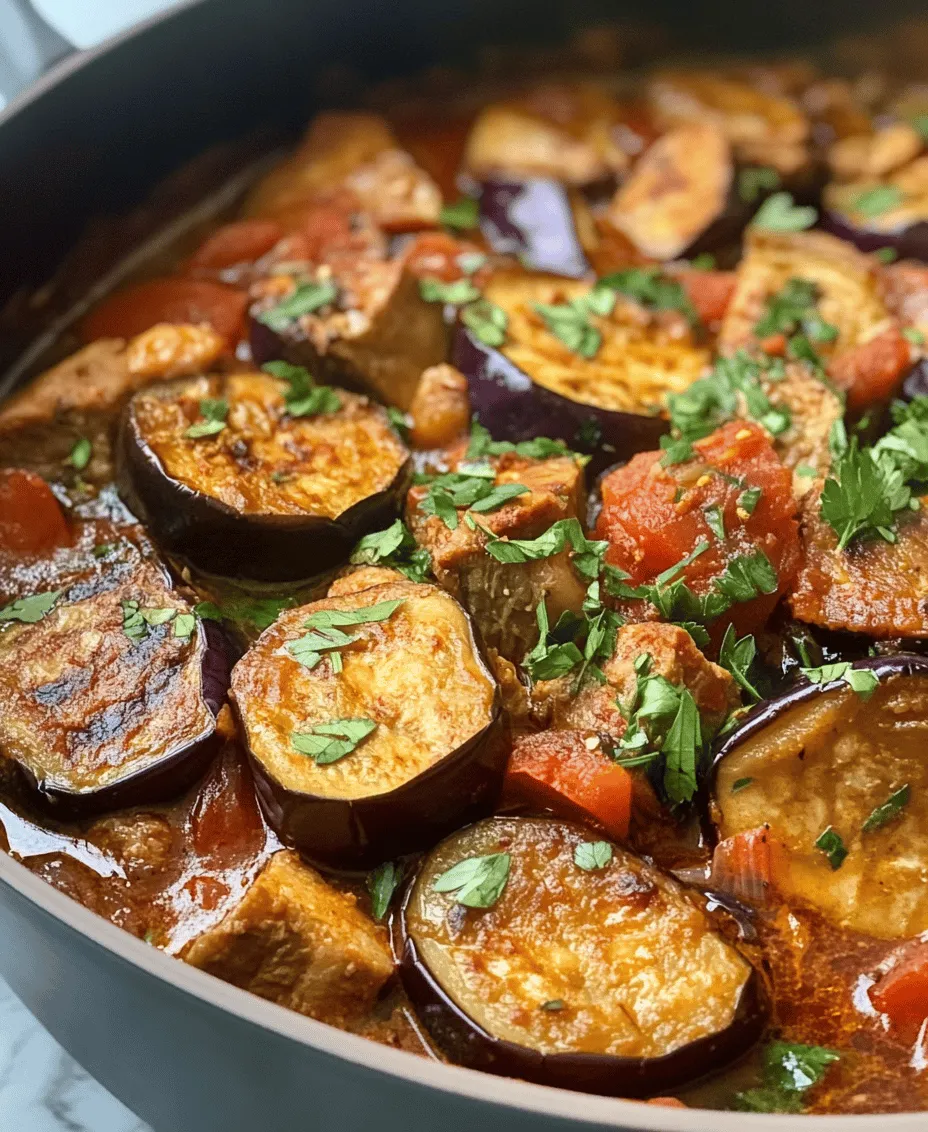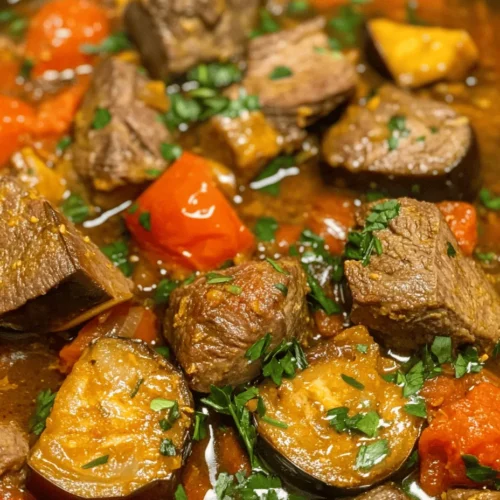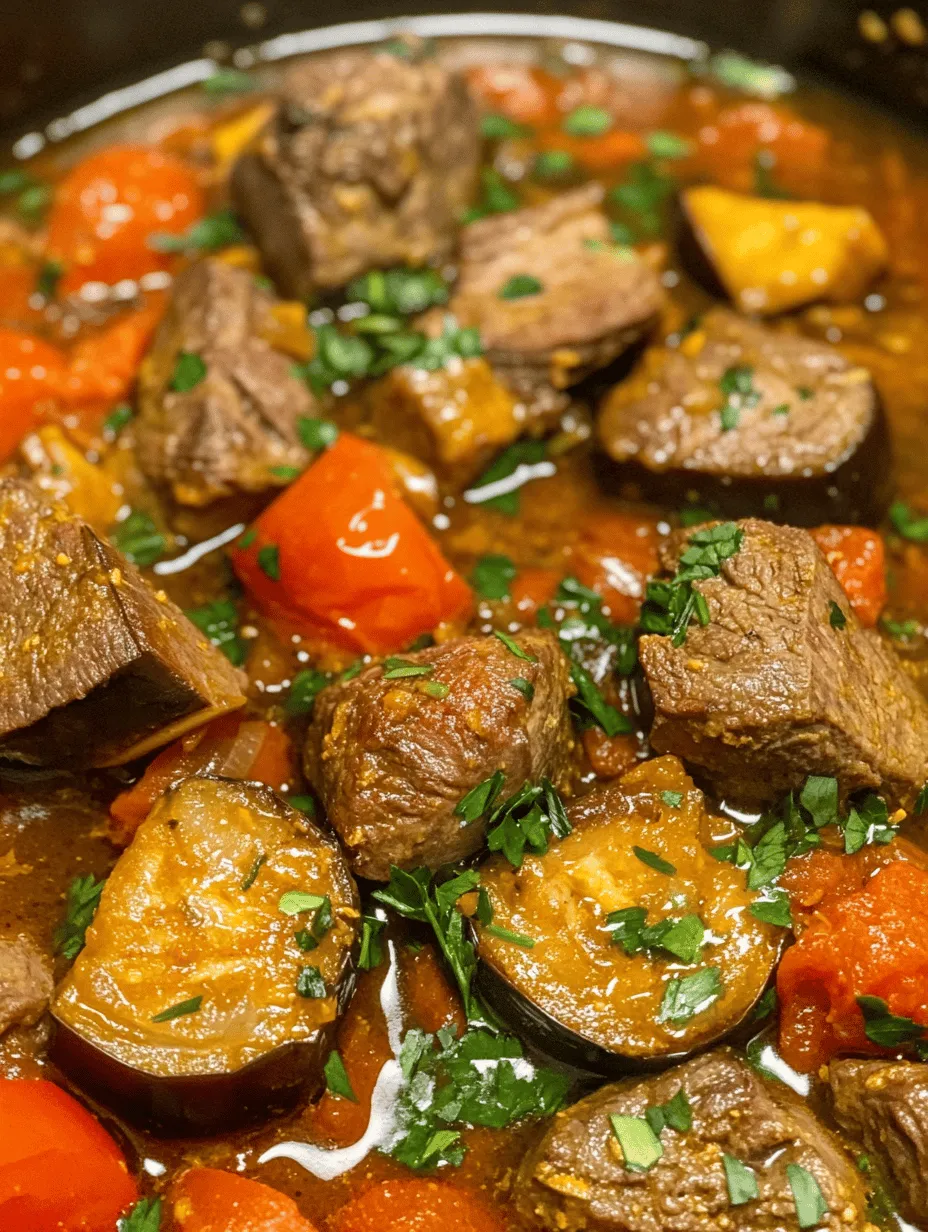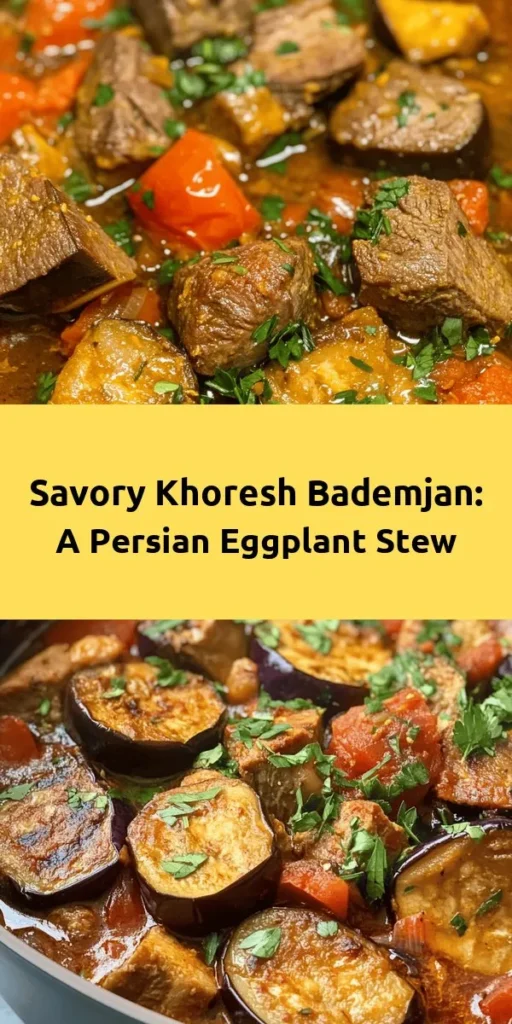Introduction
Khoresh Bademjan, often referred to as “eggplant stew,” is a beloved dish in Persian cuisine, treasured for its rich flavors and comforting qualities. This aromatic stew typically features tender meat, succulent eggplants, and a medley of spices, creating a delightful harmony of taste that has captivated generations. In Persian culture, meals are not merely about sustenance; they are a celebration of family and friendship. Khoresh Bademjan exemplifies this ethos, often gracing the tables during family gatherings and special occasions, symbolizing warmth and hospitality.
Eggplants, the star ingredient of this dish, hold a prominent place in Middle Eastern cooking. Their unique texture and ability to absorb flavors make them an ideal candidate for slow-cooked dishes. In Khoresh Bademjan, eggplants are transformed into tender morsels that meld seamlessly with the stew, contributing a depth of flavor that is both satisfying and wholesome. This dish is not just a meal; it is an experience that transports you to the heart of Persian culture.
In this article, we will delve into the intricacies of Khoresh Bademjan, exploring its historical significance, regional variations, and the nutritional benefits of its main ingredients. We will also guide you through the preparation steps to ensure your culinary adventure is both enjoyable and rewarding.
Understanding Khoresh Bademjan
Khoresh Bademjan has a rich historical background that reflects the evolution of Persian cuisine and its influences over centuries. Traditionally, khoresh, which translates to “stew,” has been a staple in Iranian households, with various regional variations emerging based on local ingredients and culinary practices. The use of eggplant in Khoresh Bademjan is believed to have originated during the Safavid period, highlighting the Persian appreciation for diverse flavors and textures.
Throughout Iran, you’ll find different interpretations of Khoresh Bademjan, each offering a unique twist to the classic recipe. In some regions, the dish may be enriched with the addition of legumes or served with a tangy sauce, while others may incorporate different types of meat, including chicken or veal. Regardless of the variation, the essence of Khoresh Bademjan remains the same: a harmonious combination of flavors that celebrates the ingredients’ natural qualities.
Beyond its cultural significance, Khoresh Bademjan is a nutritious dish. The primary ingredients—lean meats, eggplants, and a variety of vegetables—provide essential nutrients, including protein, fiber, vitamins, and minerals. Eggplants, in particular, are low in calories and high in antioxidants, making them an excellent choice for a balanced meal. The spices used in the stew, such as turmeric and cinnamon, are known for their anti-inflammatory properties, further enhancing the dish’s health benefits.
Ingredients Breakdown
To create a truly authentic Khoresh Bademjan, it’s essential to use quality ingredients that contribute to the dish’s overall flavor profile. Below, we break down each component, highlighting its role in the recipe.
– Lean Lamb or Beef: The choice of meat is crucial for the stew’s flavor. Opt for high-quality cuts of lamb or beef, as they will tenderize beautifully during the slow cooking process. The meat should be marbled with fat to ensure that it remains juicy and flavorful throughout the cooking process. The richness of the meat creates a savory base for the stew, complementing the eggplants and spices.
– Eggplants: Eggplants are the star of Khoresh Bademjan, and the variety you choose can significantly impact the dish’s outcome. Persian cuisine typically utilizes long, thin-skinned eggplants, which have fewer seeds and a less bitter taste compared to larger varieties. When selecting eggplants, look for ones that are firm, glossy, and free from blemishes. Their ability to absorb flavors makes them an integral part of this stew, adding both texture and a subtle sweetness.
– Onions and Garlic: Aromatics play a significant role in enhancing the stew’s depth. Onions are often the foundation of many Persian dishes, providing a sweet and savory base. Sautéing finely chopped onions until golden brown releases their natural sugars, creating a rich flavor that complements the other ingredients. Garlic, known for its pungent aroma and health benefits, adds an additional layer of depth to the stew.
– Spices: The use of spices in Persian cooking is what elevates Khoresh Bademjan to an art form. Turmeric, a staple in Middle Eastern cuisine, imparts a warm, earthy flavor and a beautiful golden hue to the stew. Cinnamon adds a hint of sweetness and warmth, while allspice introduces a complex flavor profile that ties all the ingredients together. The careful balance of these spices is essential to achieving the authentic taste of Khoresh Bademjan.
– Tomatoes and Broth: Tomatoes contribute acidity and sweetness to the stew, balancing the richness of the meat and eggplants. Fresh tomatoes, canned tomatoes, or tomato paste can be used, depending on what you have on hand. Additionally, using a quality broth—be it beef or vegetable—enhances the stew’s flavor, adding depth and complexity to the final dish.
– Optional Saffron: While saffron is not always included in Khoresh Bademjan, its addition can take the dish to another level. Known as the world’s most expensive spice, saffron has a unique flavor profile that is both floral and earthy. Moreover, it adds a vibrant golden color to the stew, making it visually appealing. In Persian culture, saffron is often associated with special occasions, and incorporating it into your Khoresh Bademjan can elevate the dish’s significance.
Preparation Steps
Preparing Khoresh Bademjan involves a few important steps, starting with the eggplants, as they require special attention to ensure the best flavor and texture.
– Preparing the Eggplants: The first step in making Khoresh Bademjan is to properly prepare the eggplants. Begin by slicing the eggplants into thick rounds or long strips, approximately one-inch thick. Once cut, sprinkle a generous amount of salt on the eggplant pieces and allow them to sit for about 30 minutes. This process, known as salting, draws out moisture and bitterness from the eggplants, resulting in a firmer texture when cooked. After the resting period, rinse the eggplants under cold water to remove excess salt and pat them dry with paper towels.
Salting the eggplants not only improves their taste but also prevents them from becoming mushy during the cooking process. After this initial preparation, the eggplants can be lightly fried in oil until golden brown or roasted in the oven, depending on your preference. This step enhances their flavor and creates a lovely caramelization that will make them a standout component of the stew.
By following these initial steps, you set the foundation for a delicious Khoresh Bademjan that is sure to impress your family and friends. In the following sections, we will guide you through the remaining preparation and cooking steps, ensuring you achieve the perfect balance of flavors and textures in this iconic Persian dish.

Cooking Methods for Achieving the Perfect Texture
Creating the ideal Khoresh Bademjan requires attention to detail, particularly when it comes to cooking methods that enhance the dish’s texture and flavor. The key steps in this process involve sautéing, browning, and simmering, each contributing to the overall experience of the stew.
Cooking the Stew
Sautéing Onions and Garlic: Techniques for Caramelization
Begin by heating a generous amount of oil in a large pot over medium heat. The choice of oil can significantly influence the flavor; traditional recipes often use vegetable oil or ghee for a richer taste. Once the oil is hot, add finely chopped onions, stirring occasionally to ensure even cooking. The goal is to achieve a golden-brown color, which can take about 10-15 minutes.
For optimal caramelization, avoid overcrowding the pan; if the pot is too full, the onions will steam rather than fry. Adding a pinch of salt can help draw out moisture from the onions, promoting a quicker caramelization process. Once the onions are translucent and golden, add minced garlic and sauté for an additional 1-2 minutes, just until fragrant. This step lays the foundation for a deeply flavorful base.
Browning the Meat: Importance of This Step for Flavor Development
Next, it’s time to introduce the meat. Whether you’re using lamb, beef, or chicken, browning the meat is a crucial step that enhances the dish’s complexity. Increase the heat to medium-high and add the meat in batches, ensuring not to overcrowd the pot. This allows for a good sear, which locks in juices and develops a rich, brown crust.
Cook the meat for about 5-7 minutes, turning occasionally until all sides are browned. This browning process not only adds depth to the flavor but also creates fond at the bottom of the pot, which will contribute to the stew’s overall taste once deglazed.
Combining Ingredients: How to Layer Flavors for Optimal Taste
After browning the meat, it’s time to combine the remaining ingredients. Add turmeric, cinnamon, and a pinch of black pepper to the pot, stirring well to coat the meat and onions. These spices are integral to Khoresh Bademjan, providing authentic Persian flavor. Next, pour in a couple of cups of water or broth, scraping up any browned bits from the bottom of the pot to incorporate them into the stew.
Introduce chopped tomatoes or tomato paste at this stage, which will add acidity and sweetness, balancing the richness of the meat. Bring the mixture to a gentle boil, then reduce the heat to low. This is the ideal time to add your pre-fried eggplants, which should be golden and tender. Layering these ingredients allows the flavors to meld beautifully as they simmer.
Simmering the Stew
Ideal Simmering Time and Temperature for Tender Meat
Cover the pot and let the stew simmer on low heat for about 1.5 to 2 hours. The low and slow cooking method ensures that the meat becomes tender while allowing the flavors to develop fully. It’s essential to check the stew occasionally, giving it a gentle stir and ensuring it doesn’t stick to the bottom of the pot. If necessary, add a little more liquid to maintain the desired consistency—Khoresh Bademjan should be thick yet pourable.
Incorporating Fried Eggplants: Timing for the Best Flavor Integration
If you haven’t added the fried eggplants yet, do so during the last 30 minutes of cooking. This timing allows the eggplants to absorb the flavors of the broth without becoming mushy. The eggplants will lend a creamy texture to the stew, enhancing its overall richness.
Final Seasoning Adjustments: Importance of Balancing Flavors
As the stew nears completion, taste and adjust the seasoning. You may need to add a bit more salt, a squeeze of lemon juice for acidity, or even a pinch of sugar if the stew is too acidic. These final adjustments are crucial for achieving a balanced and harmonious flavor profile, which is the hallmark of Khoresh Bademjan.
Serving Suggestions
Presentation Ideas for Khoresh Bademjan
Once your Khoresh Bademjan is ready, it’s time to present this beautiful dish. Serve the stew in a large, shallow bowl or platter, arranging the tender meat and eggplants artfully. Garnish with fresh herbs like parsley or cilantro for a pop of color. A sprinkle of pomegranate seeds can also add a delightful visual contrast, enhancing the dish’s appeal.
Recommended Accompaniments: Basmati Rice and Flatbread
Khoresh Bademjan is best enjoyed with fluffy basmati rice, which serves as the perfect canvas for soaking up the flavorful stew. You can prepare the rice traditionally, allowing it to steam until light and fluffy, or opt for a Persian-style tahdig, where the bottom layer of rice gets crispy and golden.
Flatbread, such as lavash or pita, also pairs wonderfully, allowing guests to scoop up the stew and rice, making for an interactive dining experience.
Suggestions for Pairings: Side Dishes and Beverages That Complement the Stew
To round out your meal, consider serving Khoresh Bademjan with a side salad of fresh herbs, radishes, and sliced cucumbers dressed with lemon juice and olive oil. This fresh accompaniment balances the richness of the stew.
For beverages, a lightly chilled Persian yogurt drink (doogh) can be refreshing, or you might opt for a robust red wine that complements the flavors of the meat and spices without overwhelming them.
Cultural Context
Role of Khoresh Bademjan in Persian Meals and Celebrations
Khoresh Bademjan is more than just a meal; it holds a special place in Persian culture. Often served during family gatherings and special occasions, this stew symbolizes hospitality and tradition. It is a dish that brings people together, fostering a sense of community and connection through shared meals.
The preparation of Khoresh Bademjan is often a family affair, with multiple generations coming together to create this beloved dish. It reflects the rich culinary heritage of Persia, showcasing the use of fresh ingredients, aromatic spices, and time-honored cooking techniques.
The Communal Aspect of Enjoying Stews in Middle Eastern Cultures
In many Middle Eastern cultures, stews like Khoresh Bademjan are enjoyed communally. Sharing a pot of stew encourages conversation and bonding over food. The act of serving and enjoying the meal together creates lasting memories, making it an integral part of family traditions and gatherings.
Personal Anecdotes or Stories Related to the Dish
Many who have grown up with Khoresh Bademjan recall the warmth of their homes filled with its enticing aroma. It’s often a dish prepared for celebrations, such as weddings or holidays, where family recipes are passed down through generations. For many, the first taste of Khoresh Bademjan evokes fond memories of family gatherings, laughter, and love shared over a meal.
Conclusion
Khoresh Bademjan is a delightful representation of Persian cuisine, combining layers of flavors and textures that make it a beloved dish for many. The careful selection of ingredients, the art of cooking techniques, and the communal spirit of sharing this meal come together to create a culinary experience that’s both comforting and rich in tradition.
As you explore this recipe, take the time to appreciate the process of making Khoresh Bademjan. It’s not just about the final dish; it’s about the journey of cooking, the stories shared, and the memories created with family and friends. We encourage you to dive into the world of traditional Persian cooking and share your experiences of making and enjoying Khoresh Bademjan with those you hold dear.



